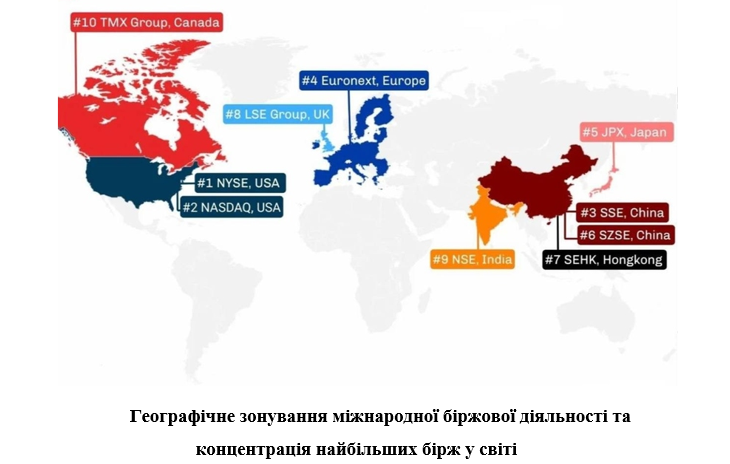1. Географічне зонування міжнародної біржової діяльності
Globalization processes and integration measures at the international level play an important role today in ensuring the accumulation and redistribution of available commodity and financial resources.
World experience shows that international exchange activity in its modern classical form is an effective mechanism in ensuring the functioning and prospective development of electronic exchange trading in futures contracts - derivatives.
International exchange electronic platforms are sufficiently transparent and open to reduce the impact of destabilizing factors in the processes of exchange pricing, forecasting and management of exchange prices.
In the current conditions, the global economic growth of international exchange trading causes the formation of competitive pricing on exchange commodity or
stock electronic platforms.
International exchange activity is an organized or regulated form of trade through the use of Internet trading technology.
Commodity and
stock exchanges are now innovative market institutions that are created and operate to meet the needs of society as effective market instruments of international importance.
International exchange operations are aimed at neutralizing destabilizing economic factors in the process of exchange futures and options pricing.
International exchange activity in countries with a market system is undergoing systematic transformational changes associated with the activation of exchange information and analytical support for exchange participants. In this regard, the choice of placing international investments on electronic exchange platforms is expanding annually and covers new types of market participants: from individuals to legal entities in the financial and commodity markets.
Over the past few decades, the level of international exchange trading has reached new records. Trading
volumes on international exchanges have dynamically increased from single transactions to daily billion-dollar transactions concluded on electronic exchange platforms.
The development of international exchange activity indicates systematic changes in different geographical zones. Globalization has accelerated the spread of advanced exchange technologies to different continents.
Modern exchange trading on international electronic exchanges remains in a state of dynamic changes in the organizational structure of exchange platforms, exchange technology for trading in derivative contracts, the development of new instruments and new exchange assets.
The main achievement of international exchange activity at the end of the last century was the introduction of electronic exchange trading technology and the development of a clearing system and collateral. Consolidation processes have created new opportunities and strengthened the competitive advantages of international exchange alliances.
Modern international exchange activity is an organized form of trading in exchange-traded futures contracts in different geographical zones.
Geographic zoning of exchange activity in the world took place according to the location of the largest exchange platforms. The classification of international exchange markets by geographical zoning is carried out by leading world-class exchange associations.

International stock exchange activity is now a universalized form of organized trade in various commodity and
financial assets, derivative contracts of a standardized form according to the
rules of stock exchange trading approved by state regulators.
In modern conditions, international stock exchange trading provides all participants with broad powers regarding investments and price risk management. Today, quite often, funds are invested not only in
securities, but also in term contracts - futures and options on futures.
The dramatic growth of international stock exchange trading has ensured the inflow of a large number of international investors in order to transfer free funds at the intercontinental level.
The volume of international stock exchange transactions in the last 25 years has constantly had an annual increase. According to statistical reports of the Futures Industry Association, today about 86 different commodity and financial exchange platforms and stock and commodity exchanges are recognized in the world.
According to the results of 2023, new record figures for the volume of international stock trading are observed - 137.44 billion, which is 63.8% higher than in 2022. At the same time, in 2022, the volume of international stock trading also increased by 34%. Thus, systematic and dynamic growth in futures and options trading volumes has been observed for two years in a row.
The list of the top 10 international exchanges in 2023 includes commodity and stock exchanges from various geographical areas:
- 6 exchanges in Asia;
- 2 exchanges in North America;
- 2 exchanges in South America;
- 1 exchange in Europe.
According to the Futures Industry Association, the first place has been held by the National Stock Exchange of India for several years in a row with a record 83.67 billion transactions.
The second and third places are occupied by two Brazilian exchanges, also with significant trading volumes - 19.31 and 6.51 billion transactions.
The fourth place in 2023 was taken by the Chicago Board of Exchanges with a trading volume of 6.10 billion transactions.
The fifth place was taken by the Korean Stock Exchange, which in 2023 entered the top 10 for the first time in the last few years with a trading volume of 1.67 billion transactions.
The sixth, seventh and eighth places were given to the Chinese commodity and financial exchanges, the ninth place to one European exchange, and the tenth to the Turkish exchange.
The largest increase was recorded on the Brazilian stock exchange – 2186%, and the largest decrease – on the Chinese Zhengzhou stock exchange – (-32.8%).
Statistical reports of the Futures Industry Association indicate the growing role of Asian exchanges in shaping modern trends in the international
stock market. To some extent, this trend is caused by global military conflicts and the growing role of more stable Asian stock markets.
In international practice, the following geographical zones are most often found, which are used to group stock market activity:
- Asian stock market region or Asia-Pacific;
- North America;
- South America;
- European region;
- Other exchanges.
Geographical zoning of international stock trading indicates the dominance of Asian exchanges in recent years.

Шрифти
Розмір шрифта
Колір тексту
Колір тла
Кернінг шрифтів
Видимість картинок
Інтервал між літерами
Висота рядка
Виділити посилання